If you’re considering a career that merges pets and business, starting your own dog training business is a great option to consider.
According to Business Insider, pet care is a “recession-proof industry.” Even better for business, 7 in 10 Millennials are pet owners – showing the pet industry isn’t slowing down any time soon.
All that said, dog training isn’t exactly an easy field to break into.
On top of requiring a certain level of knowledge regarding dog behavior, dog trainers also need to navigate all the hurdles of owning their own business (including taxes, payroll, and healthcare). Many trainers experience serious burnout and compassion fatigue from the stress of trying to help pets with serious issues and seeing dogs in tough situations.
Dog trainers are also expected to navigate the socially fraught landscape of teaching people to change their lifestyles- never an easy task!
I’ve owned my own dog training business, Journey Dog Training, since 2012. Today I’m happy to share what I’ve learned over the years. Let’s cover what you need to do to start your own dog training business – learning from my triumphs and mistakes as we go!
Dog Training Education: How Do I Get Started?
One of the most challenging aspects of starting a dog training business is figuring out what sort of training you’ll focus on, and then pursuing the right education and certification for that route.
As you consider getting into dog training, decide which areas of training you’ll focus on.
Your business, paradoxically, will likely do better if you find a niche and stick to it. My most successful trainer friends only work on aggression cases with a bite history, separation anxiety cases, puppies, or agility.
Don’t be afraid to get specific!
In fact, niching down will make your marketing, messaging, and education much easier. It simply isn’t possible to do well at all areas of dog training right away as a single person!
Choose a Dog Training Area of Expertise
There are all kinds of canine areas of expertise you can specialize in as a dog trainer. Here are a few ideas:
1. Puppy Training, Socialization, and Troubleshooting
This is a pretty logical place to start out for most new trainers, though it’s no small order to turn puppies into well-rounded adults!

2. General Obedience and Manners
This is the other most common set of dog owner problems that can be addressed by even relatively new trainers. You mostly teach new skills, rather than fixing problems.
3. Therapy Dogs, Service Dogs, and/or Emotional Support Animals
This fast-growing industry is a great next step for an experienced trainer. Service dogs must be able to obey a long list of cues in incredibly diverse situations, so be prepared for high-level training if you go this route.
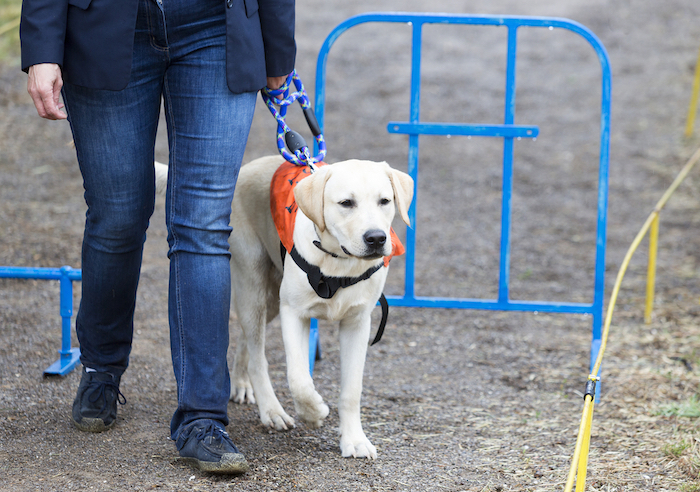
4. Adventure Training and Around Town Training
Another common niche is helping take dogs beyond basic obedience to being extra-well-behaved canine citizens of the world.
Most trainers who focus on this will also offer other training, but off-leash obedience and brewery training are incredibly popular classes in places like Colorado.
5. Dog Sport Training
If you really love teaching complex, fast behaviors, you might want to consider training competitive and performance dogs. Most sport dog trainers focus on one or two main sports rather than covering them all.
It’s best to have some titles on your own dog (meaning you’ve already placed successfully in a given sport) before attempting to teach others.
- Agility
- Obedience
- Protection sports
- Flyball
- Herding
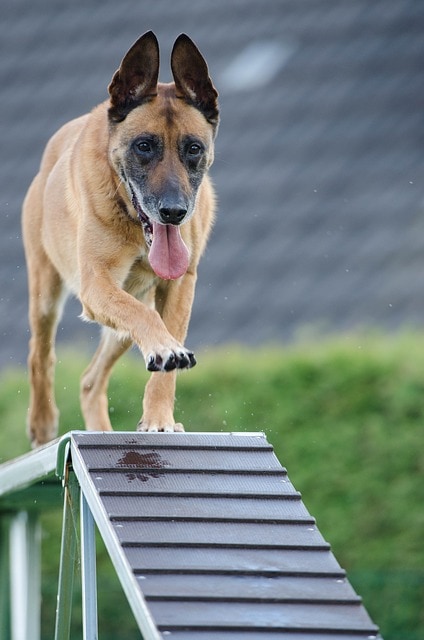
6. Reactive Dogs
Cities are full of dogs that bark and lunge at other dogs. An increasing number of facilities are now offering reactive dog group classes in addition to private sessions. This is a great introduction to behavior modification because the problem of leash-reactive dogs is so common.
7. Dogs with Phobias or Fear Issues
Many skilled trainers largely focus on helping abused, neglected, fearful, anxious, and phobic dogs live more confidently. This line of work requires a ton of patience and compassion, but it’s very rewarding.
8. Dogs with Separation Anxiety
This complicated behavior issue really benefits from experienced trainers.
Separation anxiety is a challenging but fairly common panic disorder. Helping owners work through this problem with their pets can be life-changing for both humans and canines!
We have our own (basic) guide about resolving separation anxiety – you may want to give it a read if you’re considering this line of training work.
9. Aggressive Dogs
Working with aggressive dogs, especially dogs with a bite history (meaning they’ve already bitten someone) is incredibly difficult.
You need to be prepared to almost never touch your client’s dogs (not exactly the cuddliness of puppy classes), some of your client’s dogs may be euthanized, and you may even end up involved in court cases and legal proceedings. It can be emotionally devastating and even scary work.
Think carefully about whether or not you’re actually prepared for this subset of dog training.

Generally, it’s best to start teaching puppies or general obedience before moving to competitive sports or behavior issues. This approach lets you practice running your own business and teaching people without as much pressure.
2. Become a Dog Training Pro (Through Classes or Mentorship)
Once you know what aspect of dog training you want to focus on, it’s time to get yourself educated! There are a few main ways of getting experience as a dog trainer:
Option 1: Find a trainer who is willing to mentor you
This is the “traditional” way to get started in dog training, and it still works today. The tricky part is finding an experienced local trainer who you work well with and who has time to take you under their wing.

PROS: You can get amazing, hands-on, intimate feedback this way. You can build relationships quickly and start working with clients right away. Some trainers also offer small-scale trainer schools, helping you get the benefit of a set curriculum while also getting small class sizes.
CONS: If you and your trainer don’t click, this can fall apart quickly. Your education may be sporadic or incomplete based on your schedules, your trainer’s client focus, and how good at teaching your trainer is. It may take a while before you start earning money.
Option 2: Enroll in a dog training school or program
More and more dog training schools are popping up these days. Some are self-study, others are in person.

Some of the most reputable include:
- Karen Pryor Academy: $5,300 for six months of school
- Academy for Dog Trainers: $6,825 for a two-year, part time school
- Companion Animal Science Institute: $2,600 Canadian dollars for 500 hours of school
- Victoria Stilwell Academy for Dog Trainers: $2,950 for online or $6950 for in-person
- CATCH Canine Trainers Academy: $1,443 to $5,250 depending on course level
- Peacable Paws: $1,500 for a variety of six-day intensives in different specialties, including service dogs or aggression.
PROS: You get the benefit of professional teachers and a set curriculum. You’ll know how long training will take and you often graduate with a certificate. Schools are also excellent for networking!
CONS: They can be quite expensive (generally several thousand dollars), and quality varies from each school to the next. Some schools are a great introduction but should be paired with hands-on experience. It may take a while before you start earning money. Some ultra-expensive schools teach terribly outdated training methods and are actually meant to earn money for the course provider, not make you into the best trainer you can be.
Avoid schools that promote “pack-based” training methods, “traditional training” and other potentially harmful and punitive training.
These outdated training methods were falling out of prominence until recently, but have made a damaging resurgence. Pack theory, dominance theory, and the corrections-based training techniques have been thoroughly debunked and shown to be harmful.
Option 3: Get a job as an assistant trainer at a large local school or animal shelter
This is the best option for tight budgets and slightly more experienced trainers-to-be.
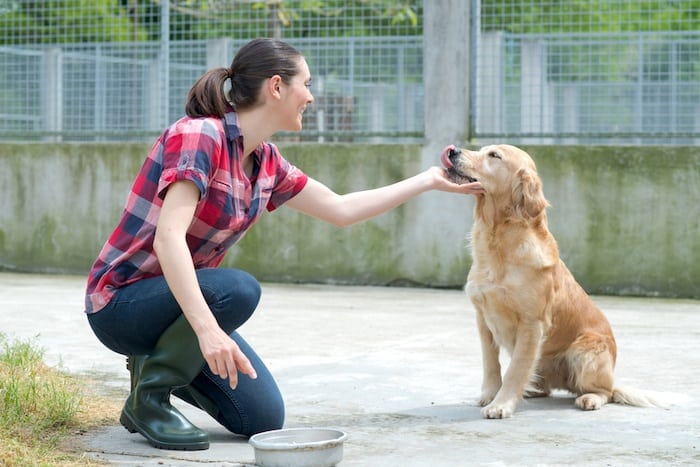
PROS: You learn while you earn a paycheck! When done correctly, this approach has all of the hands-on benefits of mentoring with the networking components of a school. Shelters in particular offer you the chance to see a huge number of new cases in a very short time.
CONS: Your main job is actually caring for the animals in front of you, so you’ll get a lot less time with actual instruction from trainers. You might spend time cleaning kennels or walking dogs rather than actually learning how to train. Many of these jobs have odd hours or poor pay, so you might still struggle financially while getting started.
Option 4: Take enough classes with your own dog that you could teach the material.
Many people get started in training because of their own dog – I don’t know many agility instructors who didn’t start as agility students, and many behavior specialists started because of their own dog’s problems.
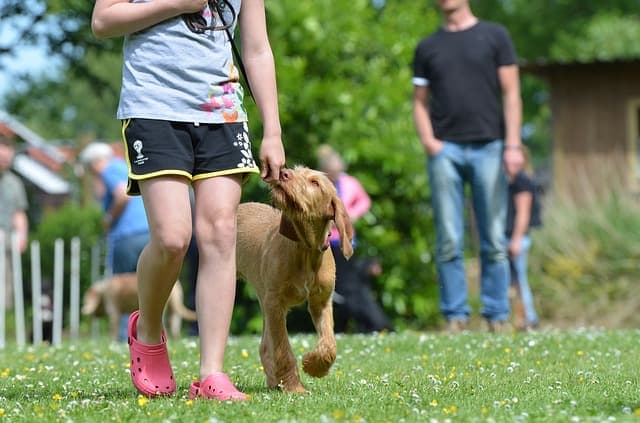
PROS: This approach progresses at your own pace. You know you love your niche, because you’re in it as a student before you launch your business. Once you’re a trainer, you’ll really understand what it’s like to be a student.
CONS: This approach only works if you’ve got your own dog and a good training facility nearby. While this approach is a great way to get started, you’ll generally have to combine it with mentorship or another approach to really be ready to take on other clients.
The important thing is that you shouldn’t try to become a dog trainer without getting lots of hands-on, deliberate practice. Good trainers need to be able to apply scientific principles to thousands of different dogs, so reading a bunch of books and training a few of your friend’s dogs doesn’t count as a complete education.
How I Became a Dog Trainer
Of course, many trainers get their start using a blend of these methods. I started out shadowing two different local trainers (#1) to get started teaching basic obedience and manners. I then fostered dogs and took classes with them (#4) to build my skills with working on behavioral issues.
After about two years of working with obedience and moderate behavioral issues, I got a job at a shelter. There, I really learned how to work with serious behavioral challenges. I continued shadowing another trainer to get more practice working on aggression cases.
I’ve taken several classes through the International Association of Animal Behavior Consultants to continue deepening my knowledge in specific types of cases, and I read a new dog training book almost every week.
Now I readily take on most behavior cases – and I don’t do much with obedience and manners anymore.
An important note: your education as a dog trainer is never complete. Good dog trainers will attend seminars and workshops, pursue new certifications and classes, and keep reading and learning forever! Just in 2018, I took seven different courses on dog training to keep deepening and expanding my knowledge.
Dog Training Certifications: Do I Need Them?
Dog training is an entirely unregulated field – many states have no laws preventing animal abusers from owning dog training businesses. You don’t actually need any kind of certification to become a dog trainer, andhis creates a serious credibility problem in the industry.
I firmly believe that seeking credentials is one of the best ways to foster trust in the dog training industry.
General Dog Training and Behavior Certifications
There are a variety of different certifications and memberships to consider. A few top picks include:
1. International Association of Animal Behavior Consultants (IAABC)
This organization is geared towards animal behavior consultants – trainers who primarily work with serious behavior problems like aggression and separation anxiety. They’re not the right fit if your goal is manners, puppies, or sports.
Members must keep up with rigorous continuing education requirements and are given the opportunity to brainstorm with a network of behavior consultants and veterinary behaviorists.
The IAABC offers four different membership levels for different experience levels. You can join as a supporting, affiliate, associate certified, or certified level. The certified level is one of the most respected certifications in dog training.
At the Certified Dog Behavior Consultant level, members must pass an exam, write case studies, collect references from vets and clients, have over 500 hours of in-person training, over 400 hours of coursework, and write discussions and recommendations for four example cases.
Membership costs between $115 and $235 for certification plus the first year of dues, depending on your certification level.
If you’re interested in behavior, join at the supporting level while you learn more!
2. Certification Council for Professional Dog Trainers (CCPDT)
The CCPDT is geared towards trainers as well as behavior consultants. Like the IAABC, it offers a few different membership levels based on your experience.
The CPTD-KSA certification is one of the only certifications that requires you to demonstrate your skills in front of an evaluator. Like with the IAABC, you’ll be expected to commit to positive reinforcement and continuing education.
Membership and certification costs between $225 and $385 depending on certification level.
3. Karen Pryor Dog Training Course
Karen Pryor Trainers are certified after graduating from the Karen Pryor Academy professional mentorship program.
The advantage of this program is that it comes with the certification – you get education and certification in one go! KPA is well-recognized as a starting point for trainers.
KPA costs $5,300 for the six month education and certification.
4. Association for Professional Dog Trainers
The Association for Professional Dog Trainers (APDT) is a group that offers great networking opportunities as well as some solid educational resources for beginner trainers.
It’s $89 – $160 per year to become a member, which is less than most other certificate programs detailed here. However, it’s worth noting that certificates from here don’t hold a ton of weight. As a membership group though, it’s absolutely worth considering.
5. Pet Professional Guild
The Pet Professional Guild is another great organization for networking with other trainers and learning from more experienced industry pros.
At just $55 – $70 per year to join, it’s financially achievable no matter what your budget. However, as with the APDT, the certificate isn’t worth much and the real value comes from networking with other members.
Other Dog Training Certifications to Consider
There are many other dog training certifications out there to help you stand out from the crowd.
While it’s generally best to start with one of the five groups above, you can pursue many others, including:
- Canine Good Citizen Evaluator is a great starting point for manners, therapy, or service dog work. While the Canine Good Citizen exam (CGC) isn’t nearly as rigorous as therapy dog work, it’s an excellent starting point and a fantastic end point for manners or obedience classes!
- Certified Separation Anxiety Trainer (CSAT) is only awarded upon completion of Malena DeMartini’s exhaustive program – but it’s the best-respected stamp of approval for separation anxiety experts.
- Certified Canine Fitness Trainer (CCFT) is an excellent certification to pursue if you’re interested in dog sports. This certification comes after completion of a long online course and an intensive in-person weekend. While you certainly won’t be a vet afterwards, you’ll be well-equipped to help clients create fitness plans and assist in injury recovery.
- Fear Free Certified Trainers are recognized for their commitment to using fear-free training methods.
- Certified Nose Work Instructor is aimed at recognizing trainers who are skilled in teaching scent detection classes.
- Dog Sport Judge. You can become certified as a judge in a variety of different dog sports, as well. Your choice in those certifications will depend on the venue you aim to judge in. Being a judge isn’t the same as being an instructor, but the title will certainly earn you some credence as you grow your business!
Your certification and education level will dictate what sort of cases you’re equipped to take on and how much you should charge for them.
It’s irresponsible to start charging $100 per hour to work on separation anxiety cases when you’re not experienced enough, and it’s downright dangerous to do the equivalent with aggression.
While it’s possible to start teaching basic manners or puppy classes without expensive certifications, a professional membership will help you learn and grow regardless of your goals.
What Dog Training Services Will You Offer?
Aside from your specific client niche (discussed above), you will also need to determine how you’ll organize your classes. If you don’t plan on renting or purchasing a training facility, you’ll likely be limited to private training.
Purchasing or leasing a training facility for group classes can be a huge financial and logistical undertaking. The vast majority of trainers start by teaching private lessons first, then leasing space for just a few classes, and only then actually getting their own space.
It’s also important to research the laws behind doggie daycare facilities in your state. In Colorado, for example, there are fairly strict laws surrounding the housing facilities in doggie daycares and overnight boarding situations – which would affect a trainer who offered day training or board-and-train in Colorado.
Here are some common structures for your dog training services:
Group Classes
This is what most people think of when they imagine dog training – six or so dogs in a room learning classroom-style.
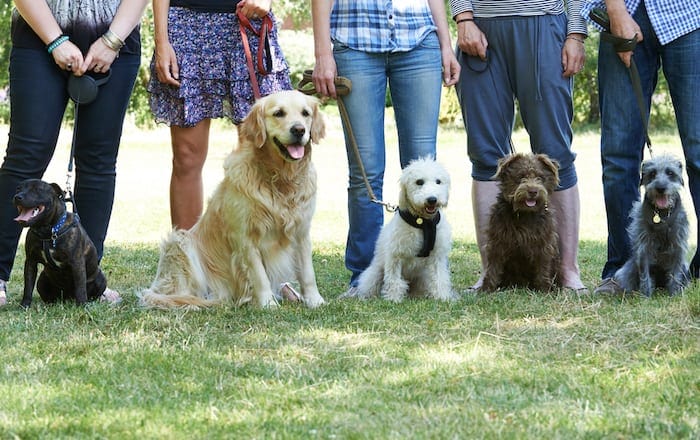
This training style is great for teaching basic manners, dog sports, and even reactive dog classes – but it’s not well-suited at all for aggression, separation anxiety, or service dogs.
You also need to be prepared to handle several dogs and handlers at once, which requires a high level of focus and adaptability as a trainer.
PROS: You can help more dogs this way. Depending on your pricing structure and schedule, you may also make more money per hour with group classes.
CONS: You will need to be able to rent space for this setup in most areas. Some cities may allow outdoor classes, but this is logistically difficult due to weather, noise, distractions, and more. When pricing out group classes, be sure to take into account what you’ll pay for a rental fee.
Private Training
Most trainers, myself included, get started with private training. Generally, you’ll drive to the client or meet in another location to work one-on-one for their training goals.
This flexible approach works for most types of training, but it’s especially essential for aggression cases, fearful dogs, and service dog work.

PROS: You can select clients carefully to match your skill level, geographic area, and schedule. Your clients benefit from your undivided attention and personalized support.
CONS: You’re constantly driving from one client to the next. If a client cancels or reschedules, your whole schedule may be disrupted. You may progress more slowly as a trainer because you’re working with fewer dogs overall.
Day Training
A fast-growing industry combines daycare and training into something that closely resembles school for children.
Owners drop their dogs off in the morning, and the trainer runs daily training sessions. This approach allows the trainer to “install” basic behaviors and get to know the dogs extremely well.

This approach is well-suited to puppies, around the town training, and basic manners. For this method, you need a facility and generally need staff help as well.
Another approach is to come and train the dogs while the owners are at work – similar to private training, but without the owner present. This is far less common.
PROS: You can focus on training for most of the day, rather than teaching owners how to train. Dogs get to socialize with each other and learn to settle around distractions when you’re not actively training.
CONS: Since the owners aren’t present, you’ll need to figure out how to do “hand-off sessions” to ensure that the owners know how to handle their dog and their dog’s new skills. If a dog is struggling with a specific issue, it can be challenging to address the problem when you have a room full of other dogs that need attention.
Board-and-Train
In a Board-and-Train scenario, the dogs stay at your facility or home for several weeks while you train them.
Like day training, this approach temporarily removes the owner from the picture. This allows the trainer to “install” behaviors before handing them off.
Some trainers do this in a kennel facility, others take just a few dogs at a time into their homes.

Starting out fostering dogs really prepares you for this sort of work, especially if you focus on basic manners.
PROS: You have much more control over when and where you train board-and-train dogs. For example, you’ll be able to work on leash walking in tightly controlled environments that ensure success. Then you can gradually add difficulty to the training for a dog. This approach is well-suited to many behavior concerns as well as service dogs who require intensive training.
CONS: There have been a lot of horror stories about dogs being abused or neglected in Board-and-Train scenarios, making owners rightly nervous. Another issue is that some owners expect perfection after these programs, and it can be difficult to teach the owners how to follow through with the training you’ve started.
Online Training

Training dogs online can be tricky, and it’s certainly not a great place to start out. You’ll need to be able to understand a client’s needs and communicate new skills to them without ever being in-person to demonstrate. But more and more people are open to this service, and it’s got a lot of great benefits.
PROS: You can reach a much broader audience and lower your prices with this approach, because you have much lower overhead cost. Plus, you can work from home!
CONS: It can be difficult to make yourself known with online dog training. It also requires some basic SEO knowledge, having a full-fledged website, and a general level online literacy Dealing with some behavior problems is incredibly difficult, as you’re fully instructing rather than training. You also don’t get to actually meet your clients’ dogs!
How to Market Your Dog Training Business
When you’re an entrepreneur, just knowing how to train a dog isn’t enough. You also have to know how to market yourself.
This means truly understanding what your skills are, how you stand apart from the competition, and why owners are looking for someone like you.
There are some basic steps that you’ll have to cover to get started with your dog training marketing plan. Of course, it’s best to ensure that your certifications and education are up-to-snuff before you get going here.
1. Set Up a Yelp Account
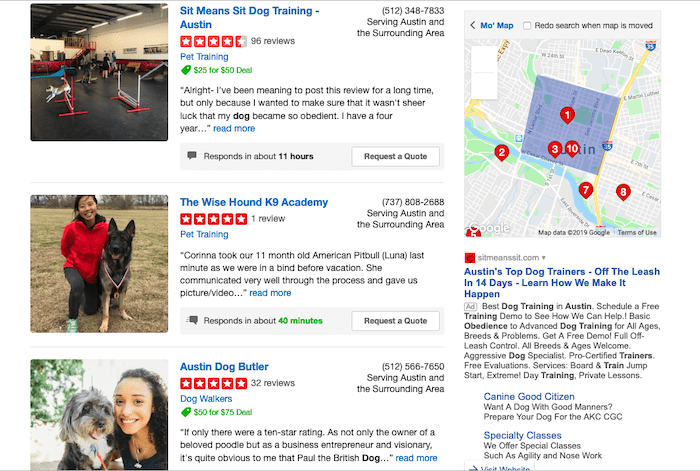
Yelp is still a go-to way for people to research businesses. Visibility on the site is a great early step in your marketing process. Creating a Yelp business account is pretty simple:
- Visit biz.yelp.com
- Click the big red “Get Started” button
- Follow the instructions on the page.
2. Set Up a Google My Business Account
You know how when you Google a business, there’s often a box on the right-hand side of the page with their hours, contact info, and some reviews? That’s thanks to Google My Business.
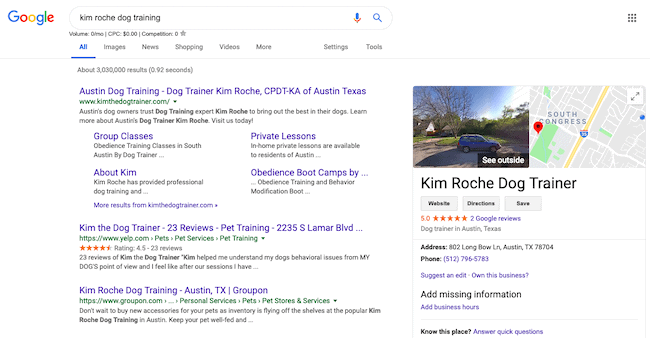
Like Yelp, this is relatively easy to set up.
- Log in to your Google Account or create one. This will be associated with your business – so don’t use the screen name you created in 2003.
- Go to Google.com/business.
- Click “Start Now” in the top right-hand corner.
- Input the information requested – be sure to be complete here.
- Verify your account using one of the methods offered. This might mean waiting for a physical postcard in the mail!
Having your Google Business account set up also means that you’ll turn up for local search results in your area when people Google topics like “dog training schools”.
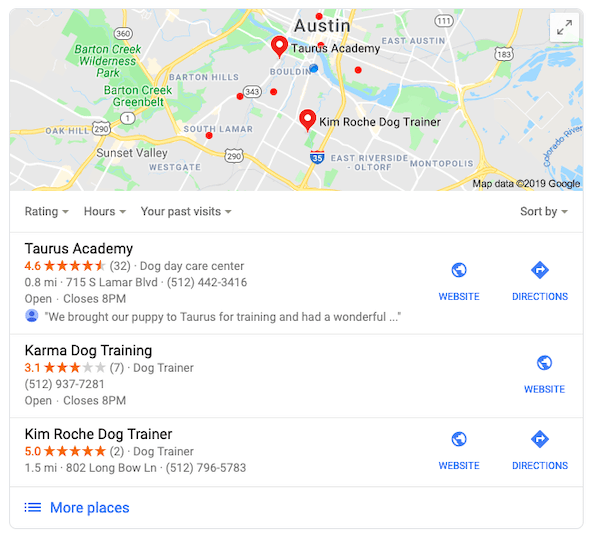
Definitely don’t pass up getting your Google Biz account set up (and don’t forget to ask clients for reviews, as those favorable star ratings go a long way on Google)!
3. Set Up a Thumbtack and/or Nextdoor Account

Both of these sites exist to help connect people with their community to get things done. As a trainer, you can post your services and respond to jobs with a bid. Depending on your area, one or both of these services might be a popular way to find clients. Both of these services are optional, but they’re a good way to find locals.
Check out Nextdoor.com and Thumbtack.com to get started – they both have setup wizards that make things easy!
4. Create a Business Website
In today’s day and age, almost everything starts with a Google search – and that means your business needs a website. Unless you’ve got deep pockets to start, I recommend just making your own website rather than paying for one.
Your main options are:
SquareSpace. Great for most small, local businesses. Easy to use and setup, with a handy built-in wizard that can set you up with a gorgeous, professional looking website quickly.

WordPress. The better option for those who are a bit more tech-savvy. You’ll have much more control over design. This guide can walk you through the process, but basically we recommend:
- buying your domain through Godaddy
- using WPX for hosting (it’s who we use, and their customer service is incredible)
- GeneratePress for your theme (but there are tons of options out there)
NOTE: Regardless of which option you choose, make sure you purchase your own domain rather than taking the free one that the one provided free (k9ofmine.com vs k9ofmine.wordpress.com / k9ofmine.squarespace.com) – it makes you look much more legitimate.
What Info Should Your Dog Training Website Include?
- A Picture Of You. A photo of you (and your dog too) helps potential customers connect with you more, rather than just reading about a faceless anybody.
- Your Certifications. Discuss your qualifications and any courses you’ve completed.
- Your Experience With Dogs. Be sure to cover any relevant experience you’ve had with dogs – that means mentorship programs, shelter volunteering, etc.
- Testimonials. Testimonials can be hugely powerful, so be sure to show them off on your website! If you’ve had a few clients who seem very happy with their results, ask them if they’d be willing to write a testimonial you can publish on your website. Asking for Yelp or Google Business reviews is also a smart idea.
- Pricing. Posting your prices and packages clearly online also helps reduce client window-shopping.
- Your Service Area. Spell out which areas of your city you work in most frequently and the radius you’re willing to travel.
- Your Class Schedule. If you’re teaching regular classes, post that schedule where it’s easy for people to find!
- Your Contact Information. Make it incredibly easy for people to find this vital information, including your phone number and e-mail address.
In addition, if you choose to use a piece of dog training business software to organize your clients and classes (which will become essential as your business grows), make sure you are using a website provider that integrates well with your selected software.
5. Grow a Community Online With Facebook Groups
Facebook groups are a great place to start making a name for yourself. There are tons of dog training Facebook groups – or you can start your own for free.

Most groups don’t allow direct selling, so be sure to offer more free advice and be truly helpful rather than sell (unless the group is OK with you directly pitching your services). You can use Facebook Groups to showcase your knowledge, and some members will naturally become clients as a result.
Joining local Facebook groups is another great way to network. When I first moved to Denver, I joined groups like “Colorado Progressive Reinforcement Trainers,” “Colorado Dog Trainers Network,” “Positive Dog Training Colorado,” and more to help meet other trainers.
Building a community can help you find mentors and get referrals quickly.
I’d also recommend joining dog business marketing groups, which can help you learn marketing tips from others in pet-related businesses. I actually run the Progressive Dog Trainers Marketing Powerhouse Facebook group – join us!
6. Network with Veterinarians and Dog Walkers
Connecting with vets and dog walkers is important, too! Many successful trainers closely partner with other local dog-based businesses. Just ensure you’re not stepping on the toes of another local trainer by trying to make this connection.

A vet friend once told me that bringing in donuts is a great way to get the vet’s attention!
Generally, just make it known that you’re open for business, what you’re qualified to help with, and where people can find you.
I find that making your niche clear makes it much easier for other trainers to refer to you (oh, she’s the local separation anxiety expert)!
7. Offer Referral Bonuses
Offer referral bonuses – give vets, trainers, dog walkers, and others a kickback if they send a client to you. This might be 20% of the first lesson or a flat fee. It’s also good to offer a signup bonus for new clients.
For example, I used to give other trainers 20% of my first lesson (usually $20) if they referred me to the client. The client also got 30% off her first lesson – this meant my take-home amount was only 50% of my posted price, but I got way more client referrals this way!
Dog Training Business Plans
You need a business plan if you’re going to be a business – not just a training plan!
I highly recommend looking at Click and Repeat or DogBiz for business planning help while you’re getting started. DogTec offers amazing dog training plans for many of their programs, meaning you’ll have curated handouts ready to go on day one! I still use many of these handouts for my clients today.
For a free business plan template, you can check out this one from BPlans. Your business plan will be long (the sample above is over 40 pages) and it will feel like a lot of work – but it will really help you visualize your goals, who your clients will be, how you’ll reach your clients, and how you’ll actually make your business succeed.
For a slightly simpler fill-in-the-blank business plan, click here.
Business plans may seem like a chore, but they’re immensely helpful for planning and budgeting your new canine business venture!
Dog Training Business Insurance
As a trainer, it’s only responsible to have business insurance. You’re working with people’s pets, and dog training business insurance will help cover you in the event that something goes wrong. Dogs can escape and get hurt, even if you’re incredibly responsible.

Business Insurers of the Carolinas is the go-to dog training business insurance (almost everyone I know uses them). You’ve got to be a member of the Association of Professional Dog Trainers to get the insurance, but it’s some of the most affordable and comprehensive on the market.
Insurance can seem expensive at first, but it’s the responsible thing to do! It’s not worth the risk to go without it.
Dog Training Business Cards
Business cards are great for feeding word of mouth. Try to carry them in your treat pouch when you’re out and about with your own dog – that’s how I got many of my “walk-up” clients.
Here are a few designs you can start with:

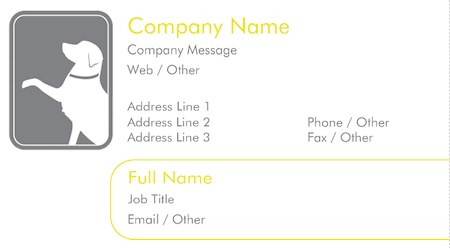
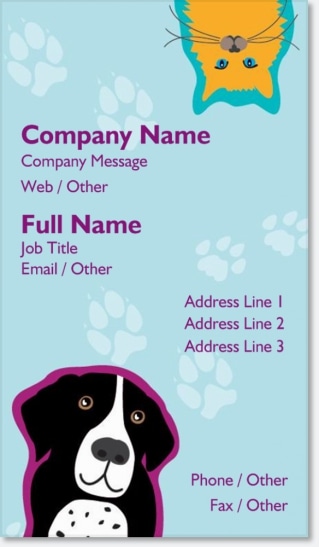
Check out these designs and more on Vistaprint.com.
Dog Training Business Name Ideas
Of course, it’s important to have a name for your new dog training business. Trying to think up a creative name for your dog training business is tons of fun!
Some tips to get you started:
- Keep it short and memorable. Long and complicated business names won’t stick as well in clients’ minds. Also avoid a name that requires you to spell out the wording, or is spoken differently than how it is written. (For example, K9 of Mine isn’t the best business name because you have to explain to people that “it’s K and 9, not canine.”)
- Think of what you want to embody in your business. I chose Journey Dog Training for my own dog training business because I wanted to evoke the idea of adventure and that training is a journey. I originally wanted the name Cognitive Canine because I’m a science geek, but the name was taken!
- Choose words that reflect your target audience. If you plan on mostly working with aggression cases, “pup” or “doggo” seems inappropriate and insensitive. Keep in mind that “K9” often invokes the idea of police or military trainers – this can be a plus or a minus, depending on your goals.
- Avoid misleading wording. If you’re not a certified dog behavior consultant or board-certified behaviorist, avoid using the word “behaviorist” in your business title.
- Check for competition or other businesses. While it’s certainly cute to use a dog-themed word in your business name, ensure you Google the name first to make sure it’s not taken.
Even if the name is available, check other local trainers to make sure you’re not too similar to them. If there’s already a “Paws and Praise” trainer near you, you might not want to name your business “Paws and Reward” or “Pets and Praise.”
Some other words to get your creative juices flowing:
- Paw / Pawsitive
- Canine
- Pup
- Good Boy / Good Girl
- Furry
- Four-footer
- Four-leg
- Wet Nose
- Tail
- Wag
- Doggo
Have you started a dog training business or are considering starting one? What other steps did you take to help your dog training business succeed? We’d love to hear your tips in the comments!
Also make sure to check out our guide to starting a dog walking business if you’re considering other careers for dog lovers!
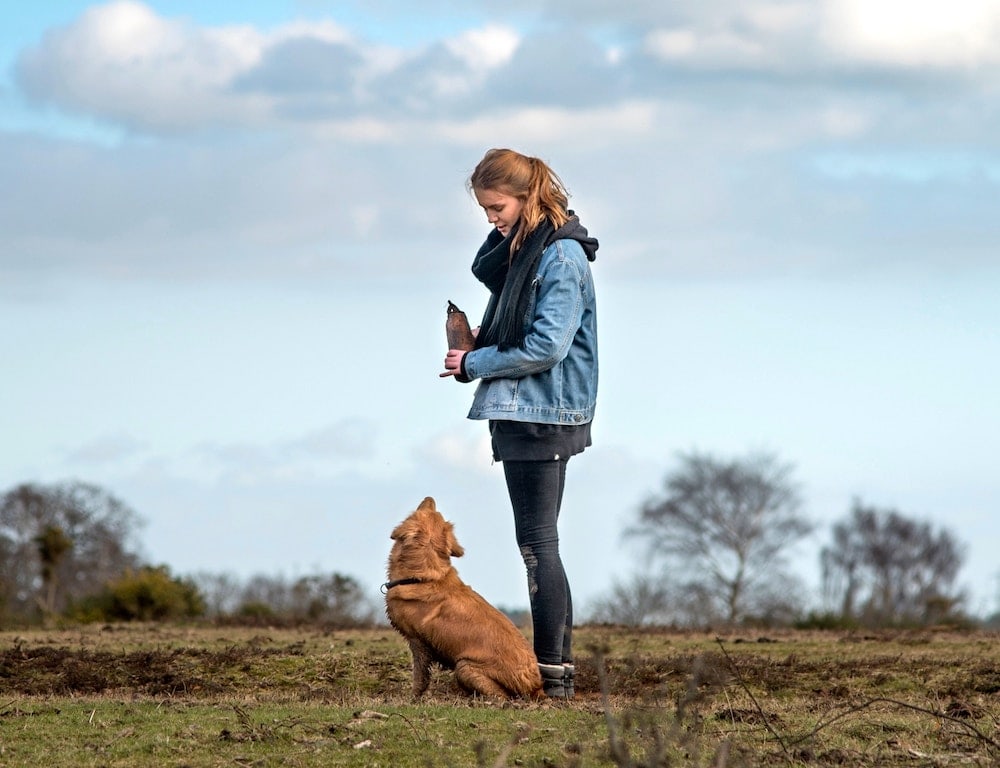





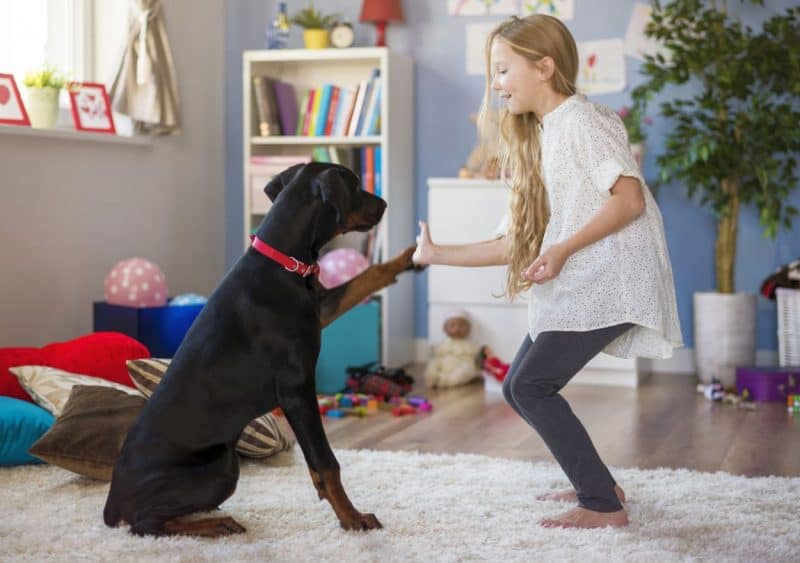

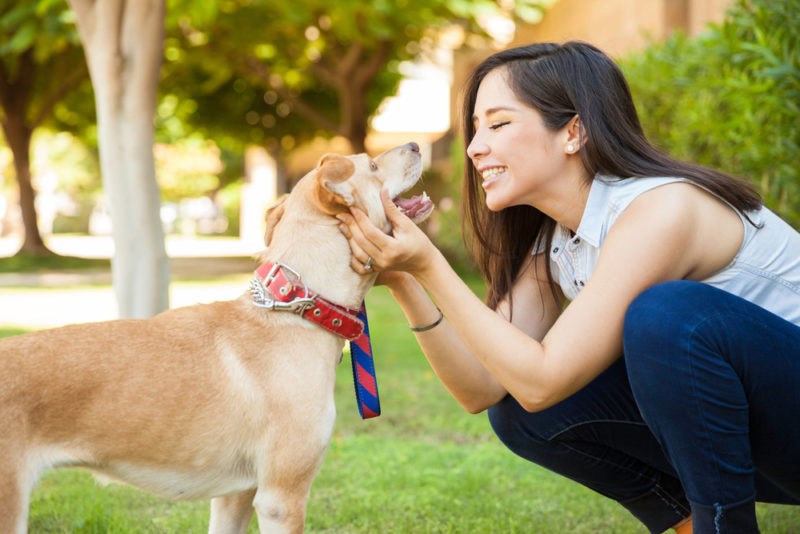


Leave a Comment